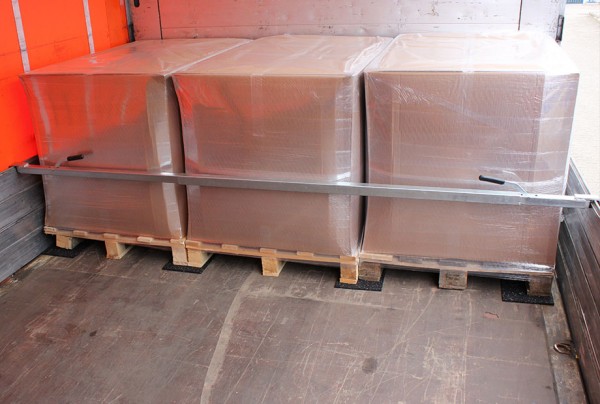Optimal safety in the transport sector
In its studies, the German Insurance Association (GDV) has shown that around 70 per cent of all lorry loads on German roads are secured insufficiently or inadequately. This is mostly based on force-fit or form-fit cargo securing. The greatest danger here is when the cargo slips, falls or rolls around on the loading area of the vehicles. Incorrect or inadequate cargo securing is not only a criminal offence in the event of damage to property or personal injury, and an administrative offence in the event of an inspection – it is also a great risk to human life and the environment. In accordance with section 22, “Cargo”, of the German Road Traffic Regulations (StVO), the loading personnel, the consignor and the driver are responsible for ensuring that the cargo is properly secured when loading the vehicle.
Rules for securing cargo
Effective cargo securing in road cargo transport is determined by the laws of physics. These laws describe the forces acting on the cargo during sudden evasive action, emergency braking, acceleration or cornering. Depending on the type of commercial vehicle and the nature of the cargo (shape, weight, packaging), these forces are absorbed by force-fit or form-fit locking with the help of cargo securing.
Industrial standards (DIN EN) and information publications from the German Statutory Accident Insurers (DGUV), the VDI guidelines (e.g. VDI 2700) and trade associations contain information, regulations, examples and instructions, for example for the calculation of required aids such as shoring beams and other cargo securing equipment.
Form-fitting cargo securing: Easy to understand and briefly explained
With form-fit cargo securing, the cargo is secured by being loaded flush and without any gaps or by means of diagonal and transverse lashing. Furthermore, lashing (rigid lashing by means of lashing straps) on the loading area of the vehicle along with the installation of a cargo securing net is a frequently used securing method.
In the case of loads secured by form fit, it must be ensured either that any gaps between the vehicle wall and the cargo or individual parts of the cargo are filled with foam pads, dunnage bags, shoring beams or decking beams or that all sides of the cargo rest against the vehicle’s load compartment boundaries (side walls, front wall). Lashing devices (lashing tracks, lashing straps) or prefabricated restraint systems made of lashing straps (lashings) are also used. The highest level of safety is provided by a cargo securing system consisting of various aids.
Further aids and components of form fit cargo securing
Anti-slip mats: These mats are placed under the cargo and thus increase the frictional force. The increased coefficient of sliding friction prevents slippage and reduces the required securing forces.
Foam mats and dunnage bags: These aids fill gaps between the packaging or the cargo in the case of form fit, and gives them extra protection. Decking beam and shoring beam: With lashing tracks, decking beams and shoring beams, the cargo space can be divided into sections. Lashing tracks have hole patterns that lashing straps can be attached to with the help of fittings; they can be used both horizontally and vertically for cargo securing. Shoring beams can also be inserted into the hole pattern for a form fit. The load limits for fasteners used for form fit cargo securing must always be observed.
Lashing devices: Lashing tracks and lashing straps as well as prefabricated lashing systems (cargo securing nets) are used for diagonal lashing and for direct lashing techniques (bay lashing, head lashing). The weight of the cargo, friction (sliding coefficient of friction), dimensions and lashing angle are decisive for calculating the quality and number of lashing straps to be used. When using lashing straps, appropriate edge protection should be used for cargo securing in order to achieve optimum force transmission and to avoid damage to the cargo.
Anchorage points for form fit cargo securing
Anchorage points are points into which lashing straps or a cargo securing net can be hooked. The anchorage points are made of robust materials and are also called load blocks, load points, lashing points, slinging swivels, transport rings or lashing rings. Transporters or lorries are equipped with anchorage points as standard. Components such as lashing tracks can also be retrofitted.









